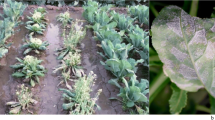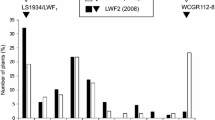Abstract
Gametophytic selection can drastically reduce the number of selection cycles during crop improvement programs. The objective of the present investigation was to test whether the nature of inheritance of two unlinked disease-resistant loci, h 1 and h 2, against Fusarium wilt in chickpea (Cicer arietinum L.) under gametophytic (pollen) selection was similar to that already observed at sporophytic level. A homozygous dominant (H 1 H 1 H 2 H 2) susceptible genotype JG-62 was crossed to a recessive (h 1 h 1 h 2 h 2) resistant genotype WR-315 to produce 20 F1 hybrid seeds. In the following generation, flower buds of 10 F1 hybrid plants were subjected to toxin stress before anthesis and the remaining ten control F1 plants’ flowers were sprayed with water. Thirty-four selected BC1 plants were generated by test crossing resistant WR-315 individuals with pollen from toxin-stressed F1 individuals. Both control and treated F1 plants were selfed to produce respective F2 generations. Two DNA markers, CS-27700bp and A07C430bp, linked to susceptible alleles H 1 and H 2, respectively, were used to study the inheritance patterns of h 1 and h 2 loci in the F2 and BC1 generations. One hundred and forty-four selected F2, 129 control F2, and 34 selected backcross individuals were tested for the presence or absence of DNA markers. Except for the control F2, observed ratios of selected F2 and BC1 populations exhibited significant chi-square deviations from expected monogenic and digenic ratios. Our results suggest that gametophytic selection is as effective as that realized at the sporophytic level, and that the gametophytic selection can be an effective breeding tool for plant breeding programs.

Similar content being viewed by others
References
Abbo S, Molina C, Jungmann R, Grusak MA, Berkaitch Z, Reifen R, Kahl G, Winter P, Reifen R (2005) Quantitative trait loci governing carotenoid concentration and weight in seeds of chickpea (Cicer arietinum L.) Theor Appl Genet 111:185–195
Brinda S, Ravikumar RL (2005) Inheritance of wilt resistance in chickpea—a molecular marker analysis. Curr Sci 88:701–702
Chandler VL, Eggleston WB, Dorweiler JE (2000) Paramutation in maize. Plant Mol Biol 43:121–145
Chikkodi SB, Ravikumar RL (2000) Influence of pollen selection for Alternaria helianthi resistance on the progeny performance against leaf blight in sunflower (Helianthus annuus L). Sex Plant Reprod 12:222–226
Chikkodi SB, Ravikumar RL (2003) Effect of pollen selection for Alternaria blight resistance in sunflower on F2 generation. In: Extended summaries, National seminar on stress management in oil seeds for attaining self reliance in vegetable oils. Directorate of Oil Seed Research, Hyderabad, pp 338–339
Clarke HJ, Khan TN, Siddique KHM (2004) Pollen selection for chilling tolerance at hybridization leads to improved chickpea cultivars. Euphytica 139:65–74
Clegg MT, Kahler AL, Allard RW (1978) Estimation of life cycle components of selection in an experimental plant population. Genetics 89:765–792
Dominguez E, Cuartero J, Fernandez-Munoz R (2005) Breeding tomato for pollen tolerance to low temperatures by gametophytic selection. Euphytica 142:253–263
Edwards K, Johnstone C, Thompson C (1991) A simple and rapid method for the preparation of plant genome DNA for PCR analysis. Nucleic Acids Res 19:1849
Fedoroff N, Masson P, Banks JA (1989) Mutations, epimutations, and the developmental programming of the maize suppressor-mutator transposable element. BioEssays 10:139–144
Fernandez-Munoz R, Gonzalez-Fernandez JJ, Cuartero J (1995) Variability of pollen tolerance to low temperatures in tomato and related wild species. J Hort Sci 70:41–49
Frascaroli E, Songstad DD (2001) Pollen genotype selection for a simply inherited qualitative factor determining resistance to chlorsulfuron in maize. Theor Appl Genet 102:342–346
Grant-Downton RT, Dickinson HG (2005) Epigenetics and its implications for plant biology. I. The epigenetic network in plants. Ann Bot 96:1143–1164
Heslop-Harrison J (1980) The forgotten generation: some thoughts on the genetics and physiology of angiosperm gametophytes. In: Davies DR, Hopwood DA (eds) The plant genome, 4th John Innes symposium. John Innes Institute, Norwich, pp 1–14
Hollick JB, Dorweiler JE, Chandler VL (1997) Paramutations and related allelic interactions. Trends Genet 13:302–308
Hormaza H, Herraro M (1996) Male gametophytic selection as a plant-breeding tool. Sci Hort 65:321–333
Jablonka E, Lamb MJ (1998) Epigenetic inheritance in evolution. J Evol Biol 11:159–183
Jorgensen R (1993) The germinal inheritance of epigenetic information in plants. Philos Trans R Soc B 339:173–181
Lancaster HO (1969) The chi-squared distribution. John Wiley, New York
Landi P, Frascaroli E, Tuberosa R, Conti S (1989) Comparison between responses to gametophytic and sporophytic recurrent selection in maize (Zea mays L.). Theor Appl Genet 77:761–767
Laughnan JR, Gabay SJ (1973) Reaction of germinating maize pollen to Helminthosporium maydis pathotoxins. Crop Sci 43:681–684
Maisonneuve B, Hogenboom NG, den Nijs APM (1986) Pollen selection in breeding tomato (Lycopersicon esculentum Mill) for adaptation to low temperature. Euphytica 35:983–992
Mayer MS, Tullu A, Simon CJ, Kumar J, Kaiser WJ, Kraft JM, Muehlbauer FJ (1997) Development of a DNA marker for Fusarium wilt resistance in chickpea. Crop Sci 37:1625–1629
Mulcahy DL, Sari-Gorla M, Mulcahy GB (1996) Pollen selection—past, present and future. Sex Plant Reprod 9:353–356
Ottaviano E, Mulcahy DL (1989) Genetics of angiosperm pollen. Adv Genet 26:1–64
Pearson K (1900) On a criterion that a given system of deviations from the probable in the case of a correlated system of variables is such that it can be reasonably supposed to have arisen in random sampling. Philos Mag Ser-5 50:157–175
Pfahler PL (1983) Comparative effectiveness of pollen genotype selection in higher plants. In: Mulcahy DL, Ottaviano E (eds) Pollen: biology and implications for plant breeding. Elsevier Biomedical, New York, pp 361–366
Ravikumar RL, Patil BS (2002) Pollen response as markers (PRM) and pollen selection: novel tools in crop improvement. In: Dris R, Bary-Ryan C (eds) Plant physiology: characteristics, breeding and genetics. Science Publishers, New Hampshire, p 212
Ravikumar RL, Patil BS (2004) Effect of gamete selection on segregation of wilt susceptibility-linked DNA marker in chickpea. Curr Sci 86:642–643
Ravikumar RL, Patil BS, Salimath PM (2003) Drought tolerance in sorghum by pollen selection using osmotic stress. Euphytica 133:371–376
Sari Gorla M, Ottaviano E, Frascaroli E, Landi P (1989). Herbicide-tolerant corn by pollen selection. Sex Plant Reprod 2:65–69
Searcy KB, Mulcahy DL (1985) The parallel expression of metal tolerance in pollen and sporophytics of Silence doica (L.) Clairv, S. alba (Mill) Krause and Mimulus guttatus DC. Theor Appl Genet 69:597–602
Shobha Rani T, Ravikumar RL (2006) Sporophytic and gametophytic selection for improvement of partial resistance to Alternaria leaf blight in sunflower (Helianthus annuus L.) Euphytica 147:421–431
Singh H, Kumar J, Haware MP, Smithson JB (1987) Genetics of resistance to Fusarium wilt in chickpeas. In: Day PR, Jellis GJ (eds) Genetics and plant pathogenesis. Blackwell, Oxford, pp 339–342
Slack JMW (1998) Comments on epigenetic inheritance. J Evol Biol 11:233–237
Thippeswamy S, Ravikumar RL, Salimath PM (2005) Molecular tagging of H 2 locus of wilt (Fusarium oxysporum f. sp. cicers) resistance in chickpea. In: International conference on plant genomics and biotechnology: challenges and opportunities, October 26–28. Indira Gandhi Agricultural University, Raipur, pp 157
Upadhyaya HD, Haware MP, Kumar J, Smithson JB (1983a) Resistance to wilt in chickpea. I. Inheritance of late wilting in response to race 1. Euphytica 32:447–452
Upadhyaya HD, Smithson JB, Kumar J, Haware MP (1983b) Resistance to wilt in chickpea. II. Further evidence of two genes for resistance to race 1. Euphytica 32:749–745
Zamir D, Tanksley SD, Jones RA (1982) Haploid selection for low temperature tolerance of tomato pollen. Genetics 101:129–137
Acknowledgments
We thank two anonymous reviewers for their useful comments on an earlier version of the manuscript, and R. L. Ravikumar thanks the Defense Research and Development Organisation (DRDO), Government of India, for their financial support to carry out the research.
Author information
Authors and Affiliations
Corresponding author
Additional information
Communicated by M. Kearsey.
Rights and permissions
About this article
Cite this article
Ravikumar, R.L., Patil, B.S., Soregaon, C.D. et al. Genetic evidence for gametophytic selection of wilt resistant alleles in chickpea. Theor Appl Genet 114, 619–625 (2007). https://doi.org/10.1007/s00122-006-0462-4
Received:
Accepted:
Published:
Issue Date:
DOI: https://doi.org/10.1007/s00122-006-0462-4




